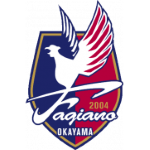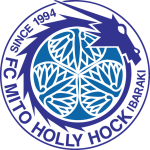| Coach | NA |
| Venue | Tapic Kenso Hiyagon Stadium |
FC Ryukyu predictions
Predictions for FC Ryukyu: See upcoming and historic predictions for FC Ryukyu below.
Disclaimer: Past performance does not guarantee future results. Betting involves risk; only wager what you can afford to lose. Always gamble responsibly.
FC Ryukyu Opinions
 Who is your favorite FC Ryukyu player of all time?
Who is your favorite FC Ryukyu player of all time?
FC Ryukyu latest results
| 06/03 | 2 - 1 |
J2 League standings
| Rank | Team | MP | W | D | L | GF | GA | GD | Pts |
|---|---|---|---|---|---|---|---|---|---|
| 1 |
 Fagiano Okayama
Fagiano Okayama
|
7 | 5 | 2 | 0 | 9 | 2 | 7 | 17 |
| 2 |
 Shimizu S-pulse
Shimizu S-pulse
|
7 | 5 | 0 | 2 | 11 | 8 | 3 | 15 |
| 3 |
 Vegalta Sendai
Vegalta Sendai
|
7 | 3 | 4 | 0 | 6 | 3 | 3 | 13 |
| 4 |
 V-varen Nagasaki
V-varen Nagasaki
|
7 | 3 | 3 | 1 | 10 | 6 | 4 | 12 |
| 5 |
 Yokohama FC
Yokohama FC
|
7 | 3 | 2 | 2 | 9 | 4 | 5 | 11 |
| 6 |
 Ventforet Kofu
Ventforet Kofu
|
7 | 3 | 2 | 2 | 11 | 8 | 3 | 11 |
| 7 |
 Renofa Yamaguchi
Renofa Yamaguchi
|
7 | 3 | 2 | 2 | 8 | 5 | 3 | 11 |
| 8 |
 Ehime FC
Ehime FC
|
7 | 3 | 1 | 3 | 9 | 8 | 1 | 10 |
| 9 |
 Montedio Yamagata
Montedio Yamagata
|
7 | 3 | 1 | 3 | 8 | 7 | 1 | 10 |
| 10 |
 Blaublitz Akita
Blaublitz Akita
|
7 | 3 | 1 | 3 | 6 | 5 | 1 | 10 |
| 11 |
 Tochigi SC
Tochigi SC
|
7 | 3 | 1 | 3 | 7 | 12 | -5 | 10 |
| 12 |
 Iwaki
Iwaki
|
7 | 2 | 3 | 2 | 11 | 5 | 6 | 9 |
| 13 |
 Oita Trinita
Oita Trinita
|
7 | 2 | 3 | 2 | 6 | 5 | 1 | 9 |
| 14 |
 Kagoshima United
Kagoshima United
|
7 | 2 | 2 | 3 | 8 | 14 | -6 | 8 |
| 15 |
 Roasso Kumamoto
Roasso Kumamoto
|
7 | 2 | 2 | 3 | 7 | 13 | -6 | 8 |
| 16 |
 JEF United Chiba
JEF United Chiba
|
7 | 2 | 1 | 4 | 12 | 12 | 0 | 7 |
| 17 |
 Fujieda MYFC
Fujieda MYFC
|
7 | 2 | 1 | 4 | 3 | 10 | -7 | 7 |
| 18 |
 Mito Hollyhock
Mito Hollyhock
|
7 | 1 | 2 | 4 | 3 | 6 | -3 | 5 |
| 19 |
 Thespakusatsu Gunma
Thespakusatsu Gunma
|
7 | 1 | 2 | 4 | 5 | 9 | -4 | 5 |
| 20 |
 Tokushima Vortis
Tokushima Vortis
|
7 | 1 | 1 | 5 | 6 | 13 | -7 | 4 |
About FC Ryukyu
FC Ryukyu is a professional football club based in Okinawa, Japan. Founded in 2003, the club is relatively young compared to other clubs in the Japanese football league system. Despite its youth, FC Ryukyu has made significant strides in the world of football, showcasing its potential and ambition to be a top-tier club.
The club's name, Ryukyu, is derived from the Ryukyu Islands, an archipelago that includes Okinawa. This name signifies the club's deep-rooted connection to its local community and its commitment to representing the region on the national stage.
FC Ryukyu began its journey in the Okinawa Prefectural League, quickly rising through the ranks to reach the Japan Football League (JFL) in 2005. After several years of consistent performance and development, the club achieved its most significant milestone in 2018 when it won the JFL and earned promotion to the J2 League, the second tier of Japanese football.
The club's home ground is the Okinawa City Athletic Stadium, also known as Tapic Kenso Hiyagon Stadium. With a capacity of over 10,000, the stadium is a symbol of the club's growth and ambition. FC Ryukyu's colors, red and blue, are prominently displayed in their crest and kit, symbolizing the vibrant culture and spirit of Okinawa.
FC Ryukyu's playing style is often described as dynamic and attacking, reflecting the club's philosophy of entertaining football. This approach has not only brought success on the pitch but also attracted a growing fan base, both locally and nationally.
Off the pitch, FC Ryukyu is committed to community engagement and development. The club regularly organizes football clinics and outreach programs in local schools and communities, fostering a love for the sport among the younger generation. Additionally, the club has been involved in various charitable activities, reflecting its commitment to social responsibility.
Despite the challenges and competition in Japanese football, FC Ryukyu continues to strive for excellence. The club's journey so far is a testament to its resilience and ambition, and there is no doubt that FC Ryukyu will continue to make its mark in the years to come.















